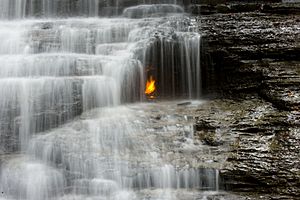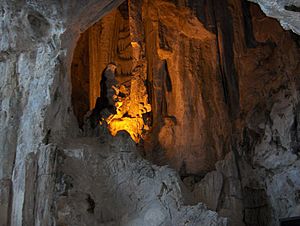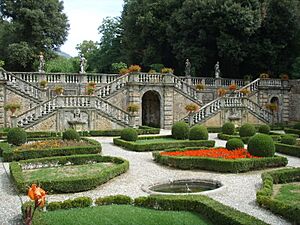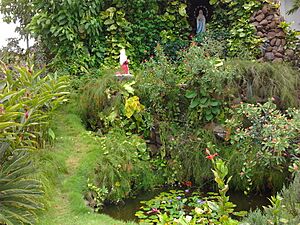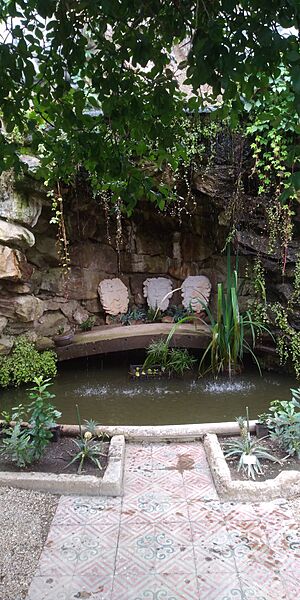Grotto facts for kids
A grotto is a natural or artificial cave or a hidden, covered space. Natural grottoes are often small caves found near water. They might be flooded, especially when the high tide comes in. Sometimes, people build artificial grottoes to decorate their garden features. Famous natural grottoes include the Grotta Azzurra in Capri, Italy, and a grotto at Tiberius's Villa Jovis in the Bay of Naples.
Contents
What is the Origin of the Word "Grotto"?
The word grotto comes from the Italian word grotta. This word itself came from an older Latin word, crypta, which means "a crypt" or hidden place.
Interestingly, grotto is also linked to the word grotesque. In the late 1400s, people in Rome found Nero's Domus Aurea palace. This palace had sunk underground over time. Its rooms were decorated with strange designs of plants, animals, and thin buildings. Because these rooms were found underground and looked so unusual, the Romans called them grottesca. This is where the French word grotesque came from.
How Were Grottoes Used in Ancient Times?
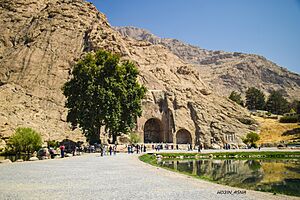
Grottoes were very popular in Greek and Roman cultures. In ancient Greece, spring-fed grottoes were important for the oracles of Apollo at places like Delphi. These were sacred spots where people believed they could get advice from the gods.
The ancient city of Rhodes had artificial grottoes carved into rocks. They were designed to look like natural caves. At a big Roman temple in Palestrina, south of Rome, the oldest part was in a grotto. A natural spring there formed a well. People believed a nymph (a nature spirit) lived in this grotto.
Grottoes as Food Cellars in Switzerland
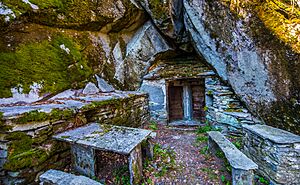
In Ticino, the Italian-speaking part of Switzerland, grottoes were used to store and keep food fresh. They were built by using the natural shapes of rocks and boulders. This created cool rooms perfect for storing milk, cheese, potatoes, sausages, and wine.
These cellars were very important. For example, there were about 40 grottoes in Maggia and around 70 in Cevio. Some grottoes have now become simple restaurants serving local food. A real grotto is dug under a rock. Cool air currents from underground keep the room cold. Often, a grotto had another floor for wine barrels. Outside, there was usually a stone table and benches for farmers to rest.
What are Garden Grottoes?
Artificial grottoes became very popular in Italian and French gardens in the mid-1500s. This was part of the Mannerist style of art and design. Two famous grottoes are in the Boboli Gardens at Palazzo Pitti in Florence. These were built between 1583 and 1593. One of them even held sculptures by Michelangelo once!
The outside of garden grottoes often looked like a huge rock or a rustic porch. Inside, they were decorated like temples. They had fountains, stalactites, and fake gems and shells. Sometimes, they featured statues of mermaids or river gods. These damp grottoes were cool places to escape the hot Italian sun. They also became popular in cooler places like France. For example, the Grotto Pavilion at the Kuskovo Estate in Russia was built in the 1700s.
Grottoes could also be used as baths. At the Palazzo del Te, there was a "Casino della Grotta." This small area had rooms built around a grotto. Courtiers would bathe in a small waterfall that splashed over pebbles and shells on the floor.
Sometimes, grottoes served as chapels. At Villa Farnese, a small theater was designed like a grotto. They were often combined with waterfalls in Renaissance gardens.
Famous garden grottoes include one designed by Bernard Palissy for Catherine de' Medici in Paris. There are also grottoes in the gardens of Versailles. In England, an early garden grotto was built at Wilton House in the 1630s.
Grottoes also fit well into less formal gardens. Pope's Grotto, created by Alexander Pope, is one of the few remaining parts of an early landscape garden in England. Pope was inspired after seeing grottoes in Italy. Other grottoes can be found in gardens like Painshill Park and Stowe. Scott's Grotto in England is a series of tunnels. They are lined with shells, flints, and colored glass.
In the 1800s, grottoes were still popular. Fingal's Cave in Scotland, a natural sea cave, inspired Felix Mendelssohn's famous "Hebrides Overture" music. Even today, architects sometimes design modern grottoes.
What are Religious Grottoes?
Today, people buy and build artificial grottoes for decoration and religious purposes. They are often used as shrines. People place statues of saints inside them, especially the Virgin Mary, in outdoor gardens.
Many Roman Catholics visit a grotto in Lourdes, France. This is where Bernadette Soubirous said she saw visions of Our Lady of Lourdes. Many garden shrines are built to look like this famous grotto. You can often find them in gardens and churches.
The largest grotto is thought to be the Grotto of the Redemption in West Bend, Iowa, USA.
Images for kids
-
Grotto in an iceberg with the Terra Nova ship in the background (1911) during the 'British Antarctic Expedition' by Herbert G. Ponting
-
Grotto pavilion in Kuskovo, Moscow (1775)
-
Anapat Grotto, Lastiver, Armenia
-
The Grotto in Bruce Peninsula National Park, Canada
See also
- Cave
- Architecture of cathedrals and great churches
- Blue Grotto, former underground wine storage vaults under the Brooklyn Bridge
- Caves of Hercules
- Grotto-heavens, Chinese religious usage
- Karst
- Shell grotto
- Tunnels in popular culture


